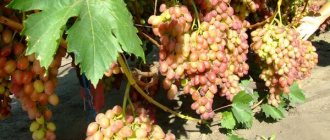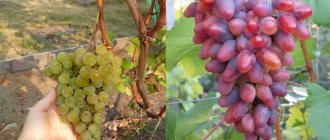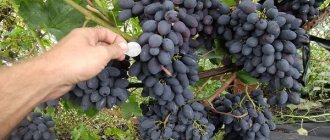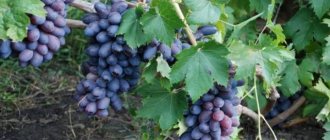History of the variety
The Attica grape variety was bred in Greece by the famous local breeder V. Michos in the late 70s of the last century. This hybrid was the result of crossing the black Kishmish grapes (Central Asian variety) and Alphonse Lavallee (French vineyard).
Photo of the Attica vineyard
The new raisin Attica grape was named after one of the Greek regions; it is distinguished by the good taste of ripe fruits, good yield and the ability to grow in many regions of Russia. But in areas with cold winters, the bushes of this grape should definitely be covered before the onset of winter.
Reviews
Analyzing the reviews, you can note their positive attitude. Many gardeners noted excellent pollination, absence of diseases, dense berries, tightly collected in clusters. Summer residents also leave positive feedback about the number of berries. The taste is not distinguished by sophistication, it is completely simple, and this is probably its charm. For many Russian gardeners, getting such a harvest in an unstable climate is a great success.
Negative aspects are associated with the taste of immature plants. It has already been noted that “Attica” has the ability to gain fruit juiciness while remaining on the bushes after ripening.
In addition, most summer residents know that difficulties in growing grapes can be associated not only with care, but also with the weather. So, quite a lot of gardeners talk about the cool summer and the subsequent taste of the crop. There is unripeness and lack of sweetness - the grapes taste bland. However, the summer residents themselves confirm that you need to be patient. In a few weeks, the taste qualities of Attika change dramatically and you can still have time to harvest before the cold weather.
For an overview of the Attica grape variety, see the following video.
Attica grapes: description and characteristics of the variety
The vigor of this vineyard is above average, so young shoots have time to ripen within a short period. Therefore, the Attica vineyard can be grown even in central Russia and regions with a similar climate, covering the vines before the onset of cold weather.
Raisin grapes Attica - photo
This seedless grape loves sunny areas and Attica is an early ripening variety.
. In the southern regions, the clusters ripen in the last ten days of July, and in colder regions - in the second ten days of August. The ripening period of the clusters directly depends on weather conditions - in hot summers the clusters ripen faster, in rainy weather the fruits ripen more slowly.
The ripening berries of the Attica variety are oval in shape, their size is up to 2.5 cm, with a small dimple at the end. The color of the dense skin, depending on the stage of ripening, can vary from purple with a bluish tint to violet, almost black. The weight of the berries is about 5 g, which have no seeds. However, in large berries weighing more than 7 g, seed rudiments may occur.
Raisin grapes Attica - video
A waxy coating is noticeable on the skin, it is strong, without viscosity, and crispy. Ripe berries of the Attica grape variety have a pleasant sweetish taste, which contains flavors of cherry and arnica. But the taste of the pulp becomes most pleasant only after the bunches have fully ripened. Although the fruits become quite dark early, their taste during ripening is not very pleasant - the fruits resemble mucus.
Interesting!
The Attica grape berries sit firmly on the stalks, so the clusters can hang on the shoots without falling off until frost. At the same time, the berries pick up sugar and become sweeter and juicier. Typically, the amount of sugar in ripe berries contains about 18%, and the amount of acid is no more than 5%.
The shape of the bunches of this grape is cone-shaped, with moderate density. At the beginning of fruiting, the clusters grow small. But in adult Attica bushes, the size of the clusters can reach 30 cm, and their weight can range from 0.7 to 1.9 kg.
The berries are not prone to cracking, tolerate transportation well over fairly long distances, and can be stored for quite a long time in appropriate conditions.
The foliage is dark emerald, clearly defined, with well-defined veins. The leaves are usually three- or five-lobed. The upper leaf plates are smooth, shiny; the reverse side of the foliage is covered with small hairs.
On a note!
Both male and female flowers bloom, so Attica grapes are self-pollinating and do not require the presence of other pollinating varieties nearby.
The bushes of this grape are undemanding to growing conditions and are distinguished by good resistance to frost - they can withstand cold temperatures down to -20 degrees Celsius without shelter.
Therefore, in Russia, the Attica vineyard is grown in the southern regions on an industrial scale, without covering it before the onset of cold weather.
Currant varieties!
• Dobrynya • Vigorous
A table variety of sultanas without seeds - Attica grapes
The Attica grape variety is recommended to be planted on their property by people who have some experience in growing grapes, despite its apparent unpretentiousness.
It will appeal to people who love sweetish, but not cloying, seedless varieties of sultanas.
It is best suited for cultivation in the south of Russia, but due to its higher frost resistance than Central Asian raisin varieties, it also grows in the middle zone.
Grapes "Attica" (Attika, Attika seedless) is a seedless table variety. Early ripening - the production period is 110-120 days from bud break. The harvest in the middle zone is harvested in July and the second ten days of August.
"Attiki" medium-strong or strong,
slightly dissected, three- or five-lobed, with bristly pubescence on their lower part.
The flowers on the vine are bisexual. Shoot ripening and yield are high.
The number of clusters on the vine at the first fruiting is on average 8, weighing up to a kilogram each.
The clusters are cylindrical, very large, dense or medium-dense, can reach 30 cm in length and, with good care, 2 kg in weight.
On average, the weight of one bunch is 700 grams. Rumba, Zarevo and Pervozvanny are in the same weight category.
The berries are oblong or round in shape, with a characteristic dimple, purple-blue or deep purple. The weight of one berry is 4-6 g.
The skin of the berries is dense, non-astringent, with a waxy coating.
The pulp is dense and crispy, sweet, with a harmonious taste. Like Ruta, the berries have a flavor reminiscent of cherries or chokeberries. There are no seeds, sometimes their rudiments are found.
The berries acquire a mature appearance until they are fully ripe, their flesh remains slimy and tasteless.
The pulp ripens after a few days, gaining juice and sugar content, making the berries larger.
“Attica” is a grape variety originally from Greece, created in 1979 at the Athens Institute of Viticulture by V. Mihos by crossing the varieties “Alphonse Lavallee” (French variety) and “Kishmish Black” (Central Asian variety).
Characteristics
The Attica variety is resistant to frost down to -21°C.
If more severe frosts are expected, after pruning the vine should be treated with a five percent solution of iron sulfate, bent to the ground and covered, for example, with spruce branches.
Sugar content - 16-18%, acidity - 5%.
Light-loving, undemanding to soil - only dislikes swampy and saline soils.
The grape yield is high - 30 tons per hectare, but rather weak in the first years. High-yielding varieties are also Rkatsiteli, Pamyati Dombkovskaya and Alexa.
It is well stored after being removed from the bush; rot does not form on it, but it loses a little weight. Only in the second week of storage do the ridges turn a little brown.
Characterized by good transportability. It is pollinated and produces a stable harvest in any weather.
It develops well without treatment with gibberellin.
Attica berries contain a large amount of vitamins and help strengthen the immune system. A high content of vitamins is also observed in the varieties Knyaginya Olga, Black Panther and Bogatyanovsky.
Diseases and pests
“Attica” is quite resistant to mildew, oidium, and very resistant to gray rot and other diseases.
It is enough to carry out only 1-2 sprayings with fungicides for prevention per season.
After the eyes open, it is best to spray the grapes with Topaz or Bayleton against oidium, to which Attica is completely unstable, before flowering with Acedan or Anthracol against mildew and anthracnose, and after flowering with Falcon (a three-component fungicide that protects grapes from oidium).
The undoubted advantage of “Attica” is that it is of no interest to wasps and other pests, such as spider mites, phylloxera grape itch and leaf rollers.
For the best yield, Attica grapes are best grown on a vertical trellis, using short or medium pruning.
Delight, Manicure Finger and Kesha feel quite good on vertical trellises.
It is better to graft it onto a vigorous rootstock in a well-lit area. The berries are usually consumed fresh, and they are also used to make excellent homemade wine and raisins.
Diversify your vineyard by planting the Attiki sultana vine and enjoy the beauty and benefits of its berries.
Useful video
If you find an error, please highlight a piece of text and press Ctrl Enter.
Grape varieties belonging to the sultana group (seedless grapes) are in demand among gardeners, since the fruits of such a berry crop are easier to process; even small children can eat the berries without choking on the seeds. Also, these varieties make the best raisins.
The Attica grape variety is the fruit of foreign selection, but is already quite popular among Russian gardeners, since it is a seedless variety, and this quality has always been valued by winegrowers.
Diseases and pests of grapes
At the genetic level, the Attica grape variety has high resistance to diseases and pest attacks.
. This vineyard has particularly high resistance to gray rot.
Plants are not affected by the following pests:
- wasps;
- leaf rollers;
- spider mites.
Useful article:
Fungicides for treating grapes against pests and diseases
However, experts recommend spraying with fungicidal preparations several times a season for preventive purposes.
Advantages
Fairly high frost resistance; in the Krasnodar region it is grown without shelter.
- high level of frost resistance;
- suitability for long-term transportation;
- high level of productivity;
- large fruits;
- voluminous bunches;
- strong structure of the bush and rhizome;
- ease of care;
- high resistance to gray rot;
- high level of resistance to attack by wasps, aphids, and mites.
The peduncles are universal, so Attica does not need the help of a neighborhood of similar varieties. The yield is quite high - eight bunches from one vine.
The first signal fruiting, seven clusters were formed.
The skin of the fruit is durable , which indicates a high level of endurance during long-term transportation. The surface is covered with a slight waxy coating. The frost resistance of the crop is high , able to withstand twenty-one degrees with a minus sign.
Flaws
The variety is prone to overloading the vine and requires the removal of excess bunches.
Attica has a number of difficulties when growing. Precisely difficulties, because it is difficult to call these components shortcomings, since they are easily eliminated.
Main difficulties:
- tendency to overload the vine;
- demands on humidity levels;
- sensitivity to temperature changes;
- demands on soil composition;
- sensitivity to fungus.
The variety is resistant to gray rot, which cannot be said about other diseases.
Despite the apparent ease of cultivation, it should be noted that full ripening is often deceptive - in fact, the plant requires several more days to reach maturity.
Therefore, control over maturation should be carried out without fail. There is often a tendency for the crop to become overloaded, so it is necessary to periodically remove excess or already ripe bunches.
Advantages of the variety
Experts include the main advantages of the Attica grape variety:
- good yield;
- absence of seeds in fruits;
- good taste of ripe berries;
- bunches of Attica sultanas are not prone to cracking;
- young shoots have time to ripen before the onset of cold weather;
- the collected bunches are perfectly stored;
- the harvested crop tolerates transportation well;
- Attica grapes are highly resistant to diseases and pest attacks.
This grape has practically no disadvantages, but it should be borne in mind that in regions with cold winters it is necessary to cover the grapevines. Also, in order to avoid overloading the vines, it is necessary to leave no more than 30 eyes on each vine.
Advantages and disadvantages
Pros:
- Sweet, but not sugary berries have notes of cherry in the taste.
- There are no bones.
- Transports well.
- Long shelf life.
- High yield.
- Large clusters and berries.
- Fruits abundantly even in unfavorable climates.
- High immunity to insect attacks.
Minuses:
- Average frost resistance.
- Demanding on soil moisture.
- Does not tolerate temperature changes well.
- The vine is prone to overload.
- May be affected by fungal diseases.
Attica grapes: planting and growing varieties
The choice of planting material is the key to future high yields. Attica grape seedlings should be strong, the height of the shoots should be about 0.5 m, the root system should be without visible damage, with 3-4 shoots.
Before planting grapes, the stems of the seedlings are cut off, leaving no more than 3-4 buds on each
. Planting holes are prepared in advance; a layer of drainage material 4-5 cm thick is laid on the bottom of each hole. A layer of garden soil mixed with potassium and phosphorus fertilizers is placed on top.
Kishmish grapes: planting and care features
The roots of grape seedlings are dipped into a solution of mullein and clay (in a ratio of 2:1), then placed in the center of the hole, carefully straightening the roots. Cover the top with the remaining nutrient substrate, carefully compacting the soil. A support is dug into each hole, to which fragile seedlings are tied.
Important!
It is better to plant these grapes in rows that are directed from north to east, and the distance between planting holes should be at least 1.8-2.0 m.
The area for planting Attica grapes should be well-lit and level, without stagnant moisture in the soil
. The groundwater level should not be closer to the soil surface than 1.9-2.2 m.
Reproduction of the variety
Attica is propagated by cuttings. It is necessary to prepare them for planting in the fall while pruning the bushes. It is worth choosing shoots that bore a large number of bunches in the summer. The diameter of the pipes should be 8-10 mm. It is worth cutting the cuttings so that each has at least 8 eyes. Also, the cuttings should not be crooked, so you should choose straight branches.
It’s worth making a notch at the bottom of the stem so you don’t forget which end to plant. It is recommended to wrap dry cuttings in film and put them in a cellar or refrigerator. In the spring, you need to remove the cuttings from the basement, evaluate their freshness, and then place them in water for 2 days, which is changed from time to time.
After this, the cuttings can be planted in individual containers, which should be covered with glass to create a greenhouse effect. Watering the substrate is required every 2 days. You can remove the lid after the first leaves appear.
Further care for Attica grapes
As soon as the seedlings take root, the pegs are removed, and trellis tying is required to form vertical growth of shoots.
To avoid overloading of shoots, vineyard bushes require regular pruning
. At the same time, weak stems are removed so that the bushes remain massive but spacious.
Important!
For high-quality fruiting of Attica grapes, no more than 2 ovaries should be left on each shoot.
After planting the seedlings, they should be watered regularly (if the season is dry). Adult bushes are watered as the soil dries.
Care
Caring for sultanas is simple, accessible even to beginners. It includes the following standard processes:
- watering;
- pruning;
- feeding
Kishmish grapes require abundant watering. Without a lot of moisture, the specific amount depends on the soil type. Under each bush you need to pour 15 liters of water every 3 days. In hot weather, watering will be required more often.
The fight against wasps in the vineyard is carried out by most winegrowers constantly.
14 days before picking berries, watering is reduced. It is enough to irrigate the ground around the bushes.
Seasonal feeding required:
- magnesium sulfate;
- magnesium monophosphate;
- sulfate.
It is recommended to apply the mineral complex at the “three leaf” stage, that is, before flowering begins. For more convenient feeding when planting next to a bush, it is worth digging a tube with a diameter of no more than 10 centimeters. This material will tell you about fertilizers for grapes.
Disease Prevention
Kishmish Attica is resistant to gray rot and fungal infections. To prevent other diseases, prophylactic treatment with fungicidal preparations is required. It will take 1 or 2 treatments during the season. Resistant to:
- wasps. Find out about protecting grapes from wasps here.
- spider mite;
- phylloxera;
- leaf roller;
- grape itch.
The leaf roller is one of the most dangerous pests for grapes.
But prevention against these pests should not be neglected. Read about the leaf roller on currants here.
Trimming
To increase yield, you will need pruning to form a bush. To avoid overload, no more than 12 vines are set aside on young bushes. It is possible to leave 25 vines for adults. Pruning is carried out at the level of 8 to 12 eyes. There should be from 10 to 12 vines per 1 square meter.
When pruning in spring, it is recommended to prune weak vines. They take the resources of the bush during wintering.
Feeding Attica grapes
Grape bushes are fed several times a season. But you need to be especially careful with nitrogen fertilizers, an excess of which can lead to active growth of the vegetative mass to the detriment of fruiting. Fertilizers containing nitrogen are applied only before Attica grapes begin to flower.
Rules for fertilizing a vineyard - video
Photo of sultana grapes Attica
The rest of the time, fertilizers containing phosphorus and potassium are applied.
Growing
Like most grape varieties, Attica sultana is light-loving. Grows well in almost any soil. Only very swampy and saline soils should be avoided. Planting cuttings in open ground is possible in spring and autumn (winter planting).
You can plant seedlings in the fall at the beginning of October until the first frost.
Cuttings of the Attica and Super Extra varieties do not require pre-treatment with Gibberellin and other growth stimulants.
For good growth and development of a young vine, a vertical trellis will be required. The vines grow actively and do not like crowding. It is good to plant it near the fence or the southern wall of the house. Cuttings should be planted at a distance of at least 1 meter from buildings. The distance between cuttings should be at least 2 - 3 meters.
Planting period
There are 2 periods for planting in open ground:
- spring (the third week of April or the first week of May, when the risk of frost disappears);
- autumn (early October, before the first frosts).
The variety requires shelter for the winter; several layers of burlap are enough. When planting seedlings before winter, you will need to insulate them by first burying the young seedlings in the ground. Find out how to prepare grapes for winter at this link.
When planting in spring, there is no need to insulate the cuttings. They adapt to winter; ordinary shelter is enough.
Ripening period
This is an early ripening variety, the period of full ripening is from 110 to 120 days from the moment of bud formation. The first harvest can be obtained at the end of July - August. The speed of ripening is not affected by weather.
Pests
Attica has good resistance to gray rot, and in relation to other fungal diseases it is at the level of grape forms of VITIS VINIFERA. As a preventative measure, it is necessary to spray plants with fungicidal compounds 1 or 2 times during the season.
A significant advantage of the variety is its resistance to damage by dangerous garden pests:
- wasps,
- spider mite,
- phylloxera,
- grape itch,
- leaf roller.
Vigorous rootstocks located in well-sunny areas are ideal for grafting this sultana. Most often, the hybrid is grown to consume its fruits in unprocessed form. They are also suitable for preparing delicious home-made wines, liqueurs, jams, compotes and raisins.
This variety of table grapes of Greek origin will be a wonderful addition to any garden: sultanas with the sonorous and unusual name Attica will annually delight owners with their beauty and tasty and healthy berries.
vvinograd.ru
Use of Attica
The variety we are considering is suitable for fresh use, and it can also be consumed in processed form. “Attika” berries are very tasty, large, and do not leave anyone indifferent.
Widely used for preservation: to seal compotes, preserves, and jams. It is also used as a wine material for homemade wine and liqueurs. Due to the absence of raisins, these grapes are used to make raisins.
“Attica” grapes, the description of the variety, photos and reviews of which indicate that this species is a high-quality grape with excellent characteristics.
“Attica” rightfully takes its rightful place in every garden, being its decoration. Proper care and care for it will bear fruit - gratitude in the form of a good harvest. This variety of grapes will only bring joy to its owners!
moyvinograd.ru
Grapes Kishmish Attica
AGRICULTURAL TECHNIQUES OF GRAPES
After the creation of new frost-resistant varieties, growing grapes became possible not only in the southern, but also in many more northern regions of Russia.
Choosing a location.
Since grapes are a heat-loving crop, to plant them you need to choose the sunniest place that is well protected from any winds. Ideally, a site near the southern wall of the house or near a brick fence, where a warmer microclimate forms, would suit him.
Grapes are a capricious plant that reacts sensitively to soil and climatic conditions. In regions with little snow and frosty winters, it is better to plant it in trenches or deep holes. In places where there is enough snow in winter and summer is too short and cold, it is better to plant grape seedlings on high ridges. In the trench, the root system of the plant will be reliably protected from freezing, and in the ridges the roots will receive more heat during the summer months.
Grapes need soil that is light, well-permeable to water and air, fertile with a neutral reaction (pH = 7). The culture does not tolerate even slight acidification. Also, grapes will not grow in areas with close groundwater (their level should be no closer than 1.5 m from the surface of the earth).
Landing.
You can plant grapes in both spring and autumn. In the northern viticulture zone, planting holes are dug to a depth of 60-70, in the southern - 40-50 cm. The distance between bushes of wine varieties is 0.8, table varieties - 1.5-2.0 m. Between the rows leave 2-2.5 m. Planting holes are filled to 1/3 of the volume with a soil mixture prepared from the top fertile layer, rotted manure or compost and sand in equal quantities. Add 4 matchboxes of superphosphate and 3 matchboxes of potassium sulfate and 2 liter cans of wood ash to each pit. They form a mound from the soil mixture and place the seedling on it, and then fill it with the remaining soil. The soil is well compacted and watered abundantly. The bush needs to create a reserve section of the stem at depth, which will be protected from any frost, so the upper bud (the place from which the vine will grow) should be below ground level.
In the first summer, the plant is usually grown in one vine, all the others are pinched. In addition, the growing vine is planted on the first 10-12 buds. When growing bushes, pay attention to how the vine becomes lignified in the fall. If it becomes woody, then next year it will bear fruit.
In the spring, after the inflorescences appear, 3 shoots are left: one with inflorescences and two lower ones, growing from the head of the bush, which will bear fruit next year. In the fall, the fruit-bearing shoot is removed, and two new ones are cut into 10-12 buds. In the same way, over the course of 5-6 years, the power of the bush is increased, creating 6-7 branches. This amount is left unchanged on each bush. In spring, 1-2 fruit shoots with clusters are left on each sleeve.
For proper formation of grape bushes, it is necessary to install a durable trellis. The simplest design consists of two metal or wooden posts with several rows of wire between them. As they grow, the vines are carefully tied to the wire, giving them the desired direction.
Remember that grapes have the property of vertical polarity. When opening, tie the fruiting arrow on a trellis or stakes only horizontally - then all annual shoots will grow equally. With a vertical garter, shoots only grow intensively from the upper eyes.
Watering.
Regular abundant watering is needed only for young vines in the first two years. For adult plants, 2-3 waterings per month are sufficient. A week before flowering, watering is stopped, as excess moisture causes flowers to fall off and delays the ripening of the crop.
Do not under any circumstances use sprinkling, which can cause fungal diseases. Watering and fertilizing are carried out through pipes, which are dug in between rows no closer than 30-50 cm to the base of the bush. Grapes do not like wet leaves and wet soil around them.
Fertilizers.
Grapes need regular fertilizing. During the active growth phase, plants are given mineral fertilizers three times a season. In the spring, once every 2 years, rotted manure is added at the rate of 7 kg per 1 m? area. In autumn, grapes require phosphorus-potassium fertilizers. They are introduced through vertically dug drainage pipes. Foliar feeding is also carried out on the leaves.
Trimming.
Young seedlings are pruned as soon as the length of the side branches reaches 12 cm. During the first pruning, 4 strong shoots are left on the central stem and 2 on the cuttings. Further adjustments to the branches are carried out annually. A week before flowering begins, the top of the vine is pinched, this is done in order to get more side shoots. To ensure that the clusters ripen well, the leaves that shade them are removed. All weak, dry and damaged stems are also broken off.
The vine grows very quickly, so every autumn excess green shoots are removed. Lignified ones are cut off by no more than 2/3, the cut should be at a right angle.
Pests and diseases.
The most common pests of grapes are phylloxera, bunch and biennial leafrollers and grape borers. For prevention, it is recommended to carry out two sprayings per season with a solution of the drug "Fufanon". The first is carried out in early spring along a green cone, the second - after harvesting.
The most dangerous diseases are mildew and oidium. To combat them, it is recommended to spray the bushes with a 1% Bordeaux mixture with the addition of colloidal sulfur from 3 to 7 times, depending on the weather. In dry summers, three sprays are enough: the first before flowering, the second a week after flowering, the third at the beginning of softening of the berries. In rainy summers, favorable for the development of diseases, grapes are sprayed 7 times: the first - when 4-5 leaves appear on the shoots, the second - before flowering, the subsequent ones - at intervals of 8-10 days.
Preparing for winter.
In the autumn, shortly before the onset of frost, the plants are mulched with humus mixed with soil in equal quantities in a layer of 8-10 cm. The grapevine is carefully bent to the ground and covered with spruce branches or a special covering material. In more northern regions, additional shelters are made on top.
Features of autumn planting of fruit tree seedlings
If you received your seedlings in late autumn or even after snow has fallen, we recommend that you do not rush to plant them in a permanent place, but save them until spring using the following methods:
A. Dig into the soil.
The place for digging the seedlings is chosen as high as possible, where stagnation of water is least possible. Dig a ditch 50 cm deep in the direction from west to east. The southern side is made sloping, the northern side is made vertical.
The seedlings are laid out in the groove one at a time (in no case in a bunch), in an inclined position (at an angle of 45 degrees), with their apex facing south. The roots and half of the trunk are covered with loose soil and watered well so that the moistened soil penetrates into all the voids between the roots; After this, the soil is added again.
To prevent the roots of buried plants from freezing, their location is covered with peat, humus or fertile soil. To protect against mice, spruce or juniper branches are placed between the seedlings and on top.
B. Storage in a snow pile.
To do this, the seedlings are placed in a bunch so that the root collars are at the same level. They are tied from top to bottom, carefully pressing the branches. The roots are covered on all sides with a damp substrate - peat, sawdust, or even better, moss - and wrapped in burlap. Then the entire bunch is wrapped in film, tied and buried deep in the snow, finding a place protected from the sun. To prevent the snow cover from melting longer, sawdust or peat is poured on top.
We advise you to pay close attention to the winterization of the label with the name of the variety. Before digging, they are wrapped in foil or plastic film and tied to the seedlings with twine that does not rot in the soil.
Competent scheme for planting grape seedlings
Appearance and botanical description
To have a complete understanding of the Attica grape variety, they study its description and characteristics and, based on this, make a conclusion: is the hybrid suitable for cultivation in a certain region or not.
Bush and shoots
Attica bushes are predominantly medium- and vigorous-growing; young shoots are characterized by good ripening during the season. For abundant fruiting, it requires pruning, pinching and removal of shoots. For cultivation, it is recommended to prepare supports so that the grapes have a rich taste and receive a sufficient amount of sunlight.
Leaves, inflorescences
The leaves of the Attica hybrid are five- or three-lobed and have a rich green color. The surface of the leaf blade is matte, slightly dissected, with slight pubescence underneath. Due to the fact that Attica produces both female and male flowers, pollinating varieties are not needed.
Already in the first year after planting, the gardener will be able to harvest the first harvest, which will only increase every year.
Bunches and berries
With proper care, the cylindrical bunches of Attica grapes reach a weight of 2 kg. The density of the hybrid clusters is high, but this does not prevent the berries from fully ripening during the season. The berries of the variety have an easily recognizable taste, which combines the sweetness of grapes and the taste of cherries. The weight of one reaches 6 grams. The color is inky blue, at the end of the fruit there is a dimple characteristic of the variety.
See also
Description of the Nizina grape variety and its characteristics, advantages and disadvantagesRead
All berries are covered with a waxy coating; when bitten, the flesh is crispy. The main advantage of Attica berries is the absence of seeds.











